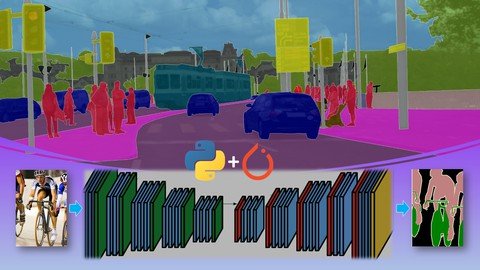
Published 1/2023
MP4 | Video: h264, 1280×720 | Audio: AAC, 44.1 KHz
Language: English | Size: 1.46 GB | Duration: 3h 6m
Learn from basics of Semantic Segmentation using Deep Learning to Implement, Train and Test YOUR own Models in PyTorch
What you’ll learn
Learn Semantic Segmentation Complete Pipeline and its Real-world Applications with Python & PyTorch using Google Colab
Deep Learning Architectures for Semantic Segmentation (UNet, DeepLabV3, PSPNet, PAN, UNet++, MTCNet etc.)
Datasets and Data annotations Tool for Semantic Segmentation
Data Augmentation and Data Loaders Implementation in PyTorch
Learn Performance Metrics (IOU, etc.) for Segmentation Models Evaluation
Transfer Learning and Pretrained Deep Resnet Architecture
Segmentation Models (UNet, PSPNet, DeepLab, PAN, UNet++) Implementation in PyTorch using different Encoder and Decoder Architectures
Learn to Optimize Hyperparameters for Segmentation Models to Improve the Performance during Training
Test Segmentation Trained Model and Calculate IOU, Class-wise IOU, Pixel Accuracy, Precision, Recall and F-score
Visualize Segmentation Results and Generate RGB Predicted Output Segmentation Map
Requirements
Deep Learning for Semantic Segmentation with Python and Pytorch is taught in this course by following a complete pipeline from Zero to Hero
No prior knowledge of Semantic Segmentation is assumed. Everything will be covered with hands-on training
A Google Gmail account is required to get started with Google Colab to write Python Code
Description
This course is designed to provide a comprehensive, hands-on experience in applying Deep Learning techniques to Semantic Segmentation problems. Are you ready to take your understanding of deep learning to the next level and learn how to apply it to real-world problems? In this course, you’ll learn how to use the power of Deep Learning to segment images and extract meaning from visual data. You’ll start with an introduction to the basics of Semantic Segmentation using Deep Learning, then move on to implementing and training your own models for Semantic Segmentation with Python and PyTorch.This course is designed for a wide range of students and professionals, including but not limited to:Machine Learning Engineers, Deep Learning Engineers, and Data Scientists who want to apply Deep Learning to Image Segmentation tasksComputer Vision Engineers and Researchers who want to learn how to use PyTorch to build and train Deep Learning models for Semantic SegmentationDevelopers who want to incorporate Semantic Segmentation capabilities into their projectsGraduates and Researchers in Computer Science, Electrical Engineering, and other related fields who want to learn about the latest advances in Deep Learning for Semantic SegmentationIn general, the course is for anyone who wants to learn how to use Deep Learning to extract meaning from visual data and gain a deeper understanding of the theory and practical applications of Semantic Segmentation using Python and PyTorchThe course covers the complete pipeline with hands-on experience of Semantic Segmentation using Deep Learning with Python and PyTorch as follows:Semantic Segmentation and its Real-World ApplicationsDeep Learning Architectures for Semantic Segmentation including Pyramid Scene Parsing Network (PSPNet), UNet, UNet++, Pyramid Attention Network (PAN), Multi-Task Contextual Network (MTCNet), DeepLabV3, etc.Datasets and Data annotations Tool for Semantic SegmentationGoogle Colab for Writing Python CodeData Augmentation and Data Loading in PyTorchPerformance Metrics (IOU) for Segmentation Models EvaluationTransfer Learning and Pretrained Deep Resnet ArchitectureSegmentation Models Implementation in PyTorch using different Encoder and Decoder ArchitecturesHyperparameters Optimization and Training of Segmentation ModelsTest Segmentation Model and Calculate IOU, Class-wise IOU, Pixel Accuracy, Precision, Recall and F-scoreVisualize Segmentation Results and Generate RGB Predicted Segmentation MapBy the end of this course, you’ll have the knowledge and skills you need to start applying Deep Learning to Semantic Segmentation problems in your own work or research. Whether you’re a Computer Vision Engineer, Data Scientist, or Developer, this course is the perfect way to take your understanding of Deep Learning to the next level. Let’s get started on this exciting journey of Deep Learning for Semantic Segmentation with Python and PyTorch.
Password/解压密码www.tbtos.com
转载请注明:0daytown » Deep Learning For Semantic Segmentation With Python, Pytorch